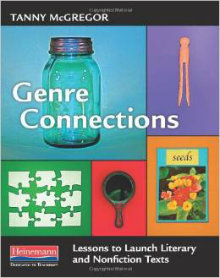An Engaging Framework for Teaching Genres
Genre Connections: Lessons to Launch Literary and Nonfiction Texts
By Tanny McGregor
(Heinemann, 2013 – Learn more)
 Reviewed by Elisa Waingort
Reviewed by Elisa Waingort
In Genre Connections, Tanny McGregor has created a manageable and effective framework for teaching a variety of text genres.
McGregor’s method can be implemented no matter what genre you are planning to teach to your students. In fact, because this framework invites and engages students through cognitive and affective devices, it can be applied to other topics and subject areas, as well.
Moreover, each chapter of Genre Connections is divided into five sections – Launching Sequence, Noticing and Naming the Genre on Their Own, Sensory Exercises, Quotations (about the genre), and Time for Text – making it easy for teachers to apply this framework to any unit.
 In this book, McGregor describes how concrete objects can serve as metaphors for particular genres by scaffolding student learning as they connect to abstract ideas. The teacher then helps students link the genre to music and art, providing time for exploration.
In this book, McGregor describes how concrete objects can serve as metaphors for particular genres by scaffolding student learning as they connect to abstract ideas. The teacher then helps students link the genre to music and art, providing time for exploration.
Relevant quotes also help students think about the genre more deeply and allow them to explore some more. Furthermore, students are given extended opportunities to talk in pairs and small groups, which permits further study of and immersion in the genre being studied.
A pattern to adapt to your topic
McGregor doesn’t tell the reader what needs to be taught. Instead, she offers a skeleton of a plan that can be used over and over again to help kids make connections to whatever topic is being taught.
The emphasis is on learning rather than on covering content and keeping track of time spent on teaching. McGregor’s approach is sensitive to learners and strays away from the stress and ineffectiveness of rushing to “cover” curriculum as is so often the focus of instruction today.
Since many of the lessons described in this book work best as an introduction to a particular genre, I wish I had read this book in August in preparation for teaching a poetry unit. McGregor’s framework would have provided an effective foundation for appreciating and understanding poetry, a foundation which middle schools students often don’t have since they tend to gravitate to fantasy and science fiction novels, instead.
Once students have a solid background and appreciation for the genre being studied, they will be able to read and write more strategically than if they hadn’t been provided with this introduction.
Understanding genres through music and art
It bears highlighting that McGregor’s emphasis on the importance of sensory connections through art and music is brilliant. This is an area where I could enhance my teaching, but since it doesn’t come naturally to me, I often don’t include the arts in my lessons. After reading McGregor’s book, I plan to be more intentional in my use of music and art to help my students grasp abstract concepts more easily.
For starters, I am planning to use the informational text chapter as my guide for my next unit. I had planned to teach nonfiction in a more traditional way by introducing text structures to my students, but McGregor’s approach has made me rethink my plan. Instead, I will immerse my students in this genre through a variety of sensory experiences (art and music) before teaching text structures.
Since my sixth and seventh grade students participate in a 40-book challenge, I am also planning mini units over the next couple of months to introduce them to some of the genres that they don’t naturally gravitate towards. I am looking forward to finding a concrete object that will make a particular genre come alive for students.
And I can only imagine how much more effective a recent unit on the various forms of government might have been if I’d thought to use concrete objects as a bridge to abstract concepts!
A variety of pathways to the study of genres
I loved this book because it provides teachers with sound advice for helping kids learn about different genres through a variety of pathways. I also loved it because of what McGregor warns us about in the epilogue, which is the importance of seeing this book as a guide and not a script. She exhorts the reader to put his or her own flavor or mark on the lessons and suggestions in the book.
And, although I love that McGregor cautions us not to follow her ideas word for word, I don’t think this would be possible to do because there are no recipes in this book. Instead, there is a clear framework and some teaching ideas that have worked for McGregor, and then the rest is up to each individual teacher.
If you’ve never read any of Tanny McGregor’s books, I encourage you to pick up Genre Connections. You won’t regret it. In fact, this book will lead you to other very practical classroom titles authored by McGregor that will enhance your teaching repertoire. Happy reading!
Elisa Waingort has been teaching in bilingual settings for more than 25 years in public and international schools in North and South America. She is currently teaching ESL in middle school at Academia Cotopaxi, an American International School in Quito, Ecuador. Elisa blogs at A Teacher’s Ruminations and is a member of Cooperative Catalyst. She is also a member of the Elementary Section Steering Committee of the National Council of Teachers of English and serves on NCTE’s Executive Committee. She is uncovering Twitter’s power @elisaw5.
































